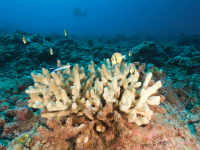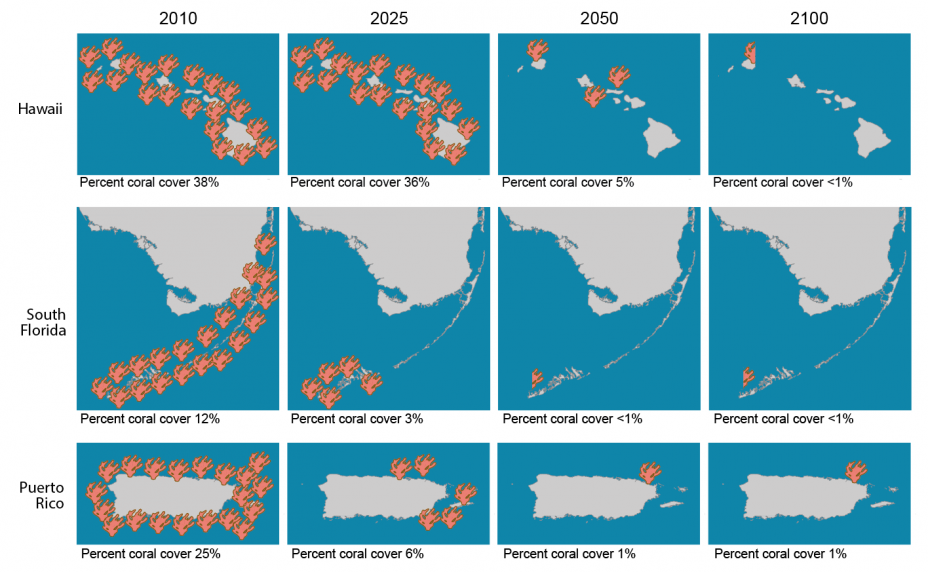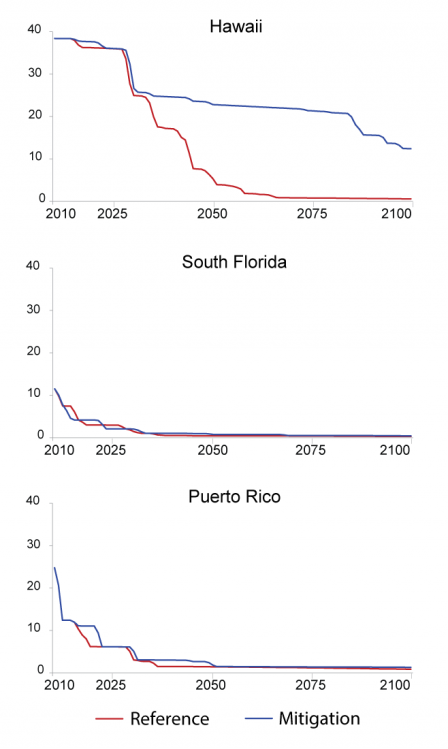Climate Action Benefits: Coral Reefs

Coral reefs, including those found in Hawaii and the Caribbean, are unique ecosystems that are home to large numbers of marine plant and animal species. They also provide vital fish spawning habitat, protect shorelines, and are valuable for recreation and tourism. However, shallow-water coral reefs are highly vulnerable to climate change.3 High water temperatures can cause coral to expel the symbiotic algae that provide nourishment and vibrant color for their hosts. This coral bleaching can cause the coral to die. In addition, ocean acidification (ocean chemistry changes due to elevated atmospheric CO2) can reduce the availability of certain minerals in seawater that are needed to build and maintain coral skeletons.
On this page:
Additional information:
Key Findings
- Coral reefs are already disappearing due to climate change and other non-climate stressors. Temperature increases and ocean acidification are projected to further reduce coral cover in the future.
- Without global GHG mitigation, extensive loss of shallow corals is projected by 2050 for major U.S. reef locations. Global GHG mitigation delays Hawaiian coral reef loss compared to the Reference scenario, but provides only minor benefits to coral cover in South Florida and Puerto Rico, as these reefs are already close to critical thresholds of ecosystem loss.
- GHG mitigation results in approximately $22 billion (discounted at 3%) in recreational benefits through 2100 for all three regions, compared to a future without emission reductions.
Risks of Inaction
Without GHG mitigation, continued warming and ocean acidification will have very significant effects on coral reefs. For major U.S. reefs, projections under the Reference show extensive bleaching and dramatic loss of shallow coral cover occurring by 2050, and near complete loss by 2100. In Hawaii, coral cover is projected to decline from 38% (current coral cover) to approximately 5% by 2050, with further declines thereafter. In Florida and Puerto Rico, where present-day temperatures are already close to bleaching thresholds and where these reefs have historically been affected by non-climate stressors, coral is projected to disappear even faster.4 This drastic decline in coral reef cover, indicating the exceedance of an ecosystem threshold, could have significant ecological and economic consequences at regional levels. These projections of shallow coral loss for major U.S. reefs are consistent with the findings of the assessment literature.5
Figure 1. Projected Impact of Unmitigated Climate Change on Coral Reef Cover in the U.S.
 Approximate reduction in coral cover at each location under the Reference scenario relative to the initial percent cover. Coral icons do not represent exact reef locations. Results for 2075 are omitted as there is very little change projected between 2050 and 2100.
Approximate reduction in coral cover at each location under the Reference scenario relative to the initial percent cover. Coral icons do not represent exact reef locations. Results for 2075 are omitted as there is very little change projected between 2050 and 2100.
download the figure; download the data
Reducing Impacts through GHG Mitigation
Mitigating global GHG emissions can reduce only some of the projected biological and economic impacts of climate change on coral reefs in the U.S. Figure 2 shows projected coral reef cover over time in Hawaii, South Florida, and Puerto Rico under the Reference and Mitigation scenarios. In Hawaii, the decline in reef cover slows under the Mitigation scenario compared to the Reference, as some of the extensive bleaching episodes and effects of ocean acidification are avoided. But even under the Mitigation scenario, Hawaii is projected to eventually experience substantial reductions in coral cover. In South Florida and Puerto Rico, the projected GHG emission reductions associated with the Mitigation scenario are likely insufficient to avoid multiple bleaching and mortality events by 2025, and coral cover declines thereafter nearly as fast as in the Reference.
The delay in the projected decline of coral results in an estimated $22 billion in economic benefits for recreation across the three sites through 2100 (discounted at 3%). The majority of these recreational benefits are projected for Hawaii, with an average value through 2100 of approximately $20 billion (95% confidence interval of $10-$30 billion). In Florida, where coral reefs have already been heavily affected, recreational benefits are also positive, but notably lower at approximately $1.4 billion (95% confidence interval of $0.74-$2.1 billion). In Puerto Rico, benefits are estimated at $0.38 million (95% confidence interval of $0.20-$0.57 million), but only represent recreational benefits for permanent residents, and therefore are not directly comparable to the other locations where visits from nonresident tourists are also included. Including the economic value of other services provided by coral reefs, such as shoreline protection and fish-rearing habitat, would increase the benefits of mitigation.
Figure 2. Percent Change in Coral Reef Cover with and without Global GHG Mitigation at Major U.S. Reefs
 download the figure; download the data
download the figure; download the data
Approach
The CIRA analysis examines the physical and economic impacts of climate change and ocean acidification on coral reefs in Hawaii, South Florida, and Puerto Rico. Using the COMBO (Coral Mortality and Bleaching Output) model,6,7 the analysis first estimates declines in coral reef cover (a measure of coral reef health and density) using projections of future ocean temperature (from the IGSM-CAM) and chemistry under the CIRA Reference and Mitigation scenarios.8 The effects of future bleaching events are also estimated.
Next, the analysis quantifies the economic impacts associated with coral reef cover loss based on declines in reef-based recreation. The analysis estimates these impacts using a benefit-transfer approach; that is, it draws on reef-related recreation benefits measured in previously published studies conducted at a range of coral reef sites to estimate the value of reef-related recreation benefits in the areas considered in this study.9 Projected impacts to recreation at each site are provided with confidence intervals based on the 95% interval for per-trip recreational values.
For more information on the CIRA approach and results for the coral reef sector, please refer to Lane et al. (2013)10 and Lane et al. (2014).11

